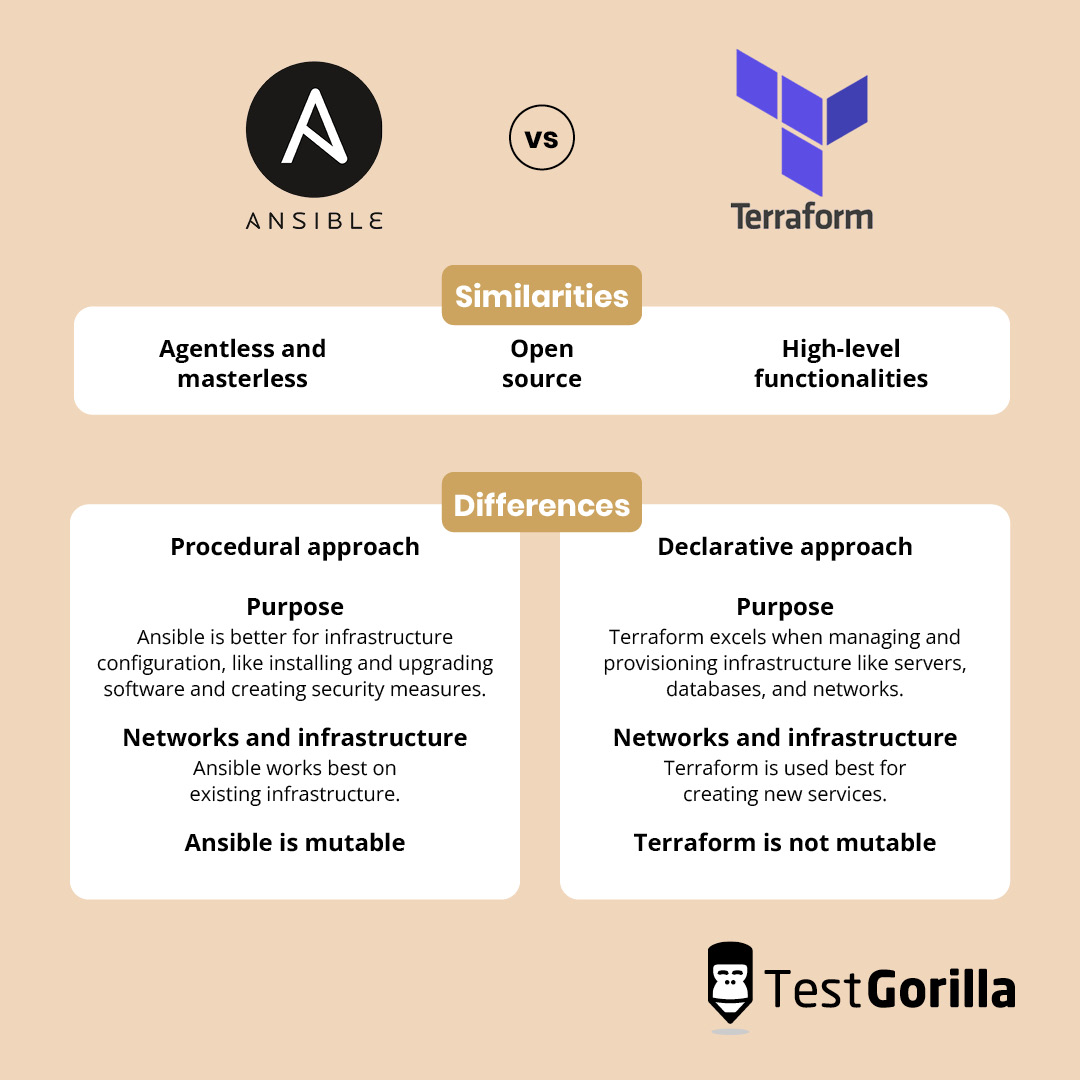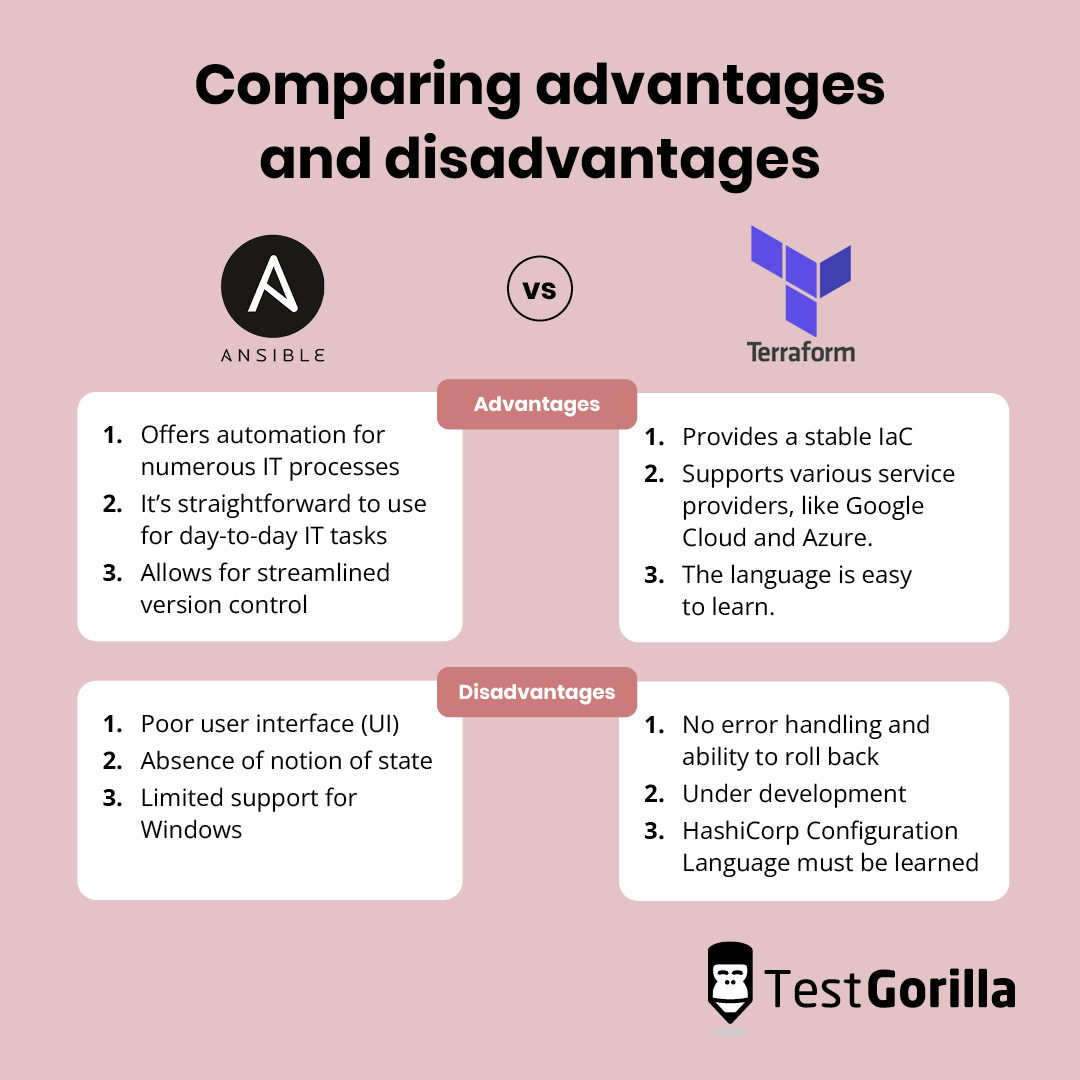Ansible vs. Terraform: Which is better for your business and why? A full comparison
Ansible and Terraform are the leading open-source software tools for the configuration of infrastructure and automation.
Terraform is an Infrastructure as code (IaC) tool that allows the codification of infrastructure configurations, which DevOps teams use for infrastructure management. Meanwhile, Ansible is an automation open-source solution for automating IT processes.
Whether your business should use Ansible or Terraform depends on your needs and what you will use the software for. Ansible will make more sense for certain functions, while Terraform would be better for others. Sometimes, both tools may be used together given their overlapping functionalities.
And if you’re looking to recruit a software engineer who can use Ansible effectively, the best way to evaluate their knowledge is with TestGorilla’s Ansible test. The test will give you an objective evaluation of their skills and expertise with the platform and enable you to hire a talented Ansible expert.
If you’re not certain whether you need someone who can use Ansible or Terraform, this article will guide you. We’ll explain what each tool does and explore their pros and cons to help you make the right decision for your business needs.
Table of contents
What is Ansible?
Ansible is an open-source IT platform written in Python and used for software automation. Its main purpose is to configure existing platforms and systems, support application deployment, configure updates, and orchestrate workflows.
Beyond that, Ansible works well for large companies that have many servers, each requiring individual installation and configuration – the platform will do these tasks on its own.
The advantages of Ansible
Ansible’s key advantage is that it offers automation for numerous IT processes, including software installation, provisioning of infrastructure, and the application of security measures.
It’s straightforward to use for day-to-day IT tasks, and it automates all of the above processes using a simple pre-written script that allows for streamlined version control.
The disadvantages of Ansible
Some of the disadvantages of Ansible include the following:
Poor user interface (UI): The initial idea behind Ansible was to offer a command-line interface (CLI) tool. The AWX GUI was its first UI; however, AWX turned into the Ansible Tower, which still needs many improvements. The CLI and GUI do not synchronize very well, which leads to conflicting query results.
Absence of notion of state: Ansible has no notion of state, which means that it executes a series of tasks and it finishes when that task is complete, the system encounters an error, or it fails to perform. This absence of state is problematic since many users will want their automation tool to keep track and catalog orders – regardless of whether something was found in error or it wasn’t completed, reaching a definite state.
Limited support for Windows: Ansible supports both Linux/Unix and Windows, but the latter is still limited due to its use of Windows’ native PowerShell rather than SSH, which can lead to automation setbacks. Since Windows is the most popular operating system, this limited support can discourage many users from using the platform.
What is Terraform?
Terraform is an IaC tool that specializes in orchestrating and provisioning data center environments. To reach an end state, Terraform creates, changes, and destroys servers instead of configuring or installing them.
The user sets the desired end state for the management of a network and Terraform performs the necessary actions to maintain it via a declarative approach.
It’s ideal for companies that use multicloud infrastructure since they can create a unified workflow across all cloud platforms.
The advantages of Terraform
Terraform provides a stable IaC that easily runs changes to the configuration and it supports various service providers, like Google Cloud and Azure.
The language for Terraform is also easy to learn as it uses HashiCorp Configuration Language (HCL), which makes it available for most software engineers.
The disadvantages of Terraform
Some of the disadvantages to Terraform include:
No error handling and ability to roll back: Currently, Terraform doesn’t have error handling, which means that try-catch cannot be used to find errors and you can’t roll back, meaning you have to delete everything and re-run it from scratch.
Under development: Terraform is still being developed and new versions and patches are being doled out each month.
HCL must be learned: Although it is easy to learn, users must have a working knowledge of HCL if they don’t want to use JSON.
How do Ansible and Terraform compare? Key similarities and differences
At a basic level, Terraform is an IaC platform used for the configuration of infrastructure, while businesses use Ansible to automate different IT processes. Comparing the two, we can see the following similarities and differences:
Ansible vs. Terraform: the similarities
Some of the characteristics the two platforms share include:
Agentless and masterless: Ansible and Terraform are agentless and masterless platforms, meaning they don’t require a dedicated server to run your state of infrastructure and they use cloud services to execute commands. Ansible does require the initial use of SSH Daemon, but the module is removed after execution.
Open source: Both platforms are open source, where numerous users share information and help to build updates, expediting the perfection of both Ansible and Terraform.
High-level functionalities: Both platforms can be used to configure new cloud infrastructure and carry out high-level functionalities for systems.
Ansible vs. Terraform: the differences
Some of the differences between the two include:
Approach: Terraforms uses a declarative approach, while Ansible uses a procedural approach.
Purpose: Terraform excels when managing and provisioning infrastructure like servers, databases, and networks. Ansible is better for infrastructure configuration, like installing and upgrading software and creating security measures.
Networks and infrastructure: Terraform is used best for creating new services, while Ansible works best on existing infrastructure.
In addition to the above, terraform is not mutable, while Ansible is.
Terraform vs. Ansible: Which one should you choose?
As we mentioned at the start, choosing between Terraform or Ansible should depend on the needs of your business.
If you’re building your infrastructure from the ground up, Terraform is the platform for you. If you want to automate and manage your existing infrastructure, then Ansible will probably work best for your needs.
Ansible is regarded as more straightforward and easy to use, but Terraform is highly intuitive, so the comparison here is moot.
To make a fully informed choice, sit down with your team and discuss your plans. This will help you select the right platform for your business and will make your life much easier in the end.
And remember, if you need to hire an Ansible expert, the best way to assess their skills objectively is to use an Ansible skills test. Get started for free today.
Related posts
Hire the best candidates with TestGorilla
Create pre-employment assessments in minutes to screen candidates, save time, and hire the best talent.
Latest posts
The best advice in pre-employment testing, in your inbox.
No spam. Unsubscribe at any time.

Hire the best. No bias. No stress.
Our screening tests identify the best candidates and make your hiring decisions faster, easier, and bias-free.
Free resources
This checklist covers key features you should look for when choosing a skills testing platform
This resource will help you develop an onboarding checklist for new hires.
How to assess your candidates' attention to detail.
Learn how to get human resources certified through HRCI or SHRM.
Learn how you can improve the level of talent at your company.
Learn how CapitalT reduced hiring bias with online skills assessments.
Learn how to make the resume process more efficient and more effective.
Improve your hiring strategy with these 7 critical recruitment metrics.
Learn how Sukhi decreased time spent reviewing resumes by 83%!
Hire more efficiently with these hacks that 99% of recruiters aren't using.
Make a business case for diversity and inclusion initiatives with this data.





















